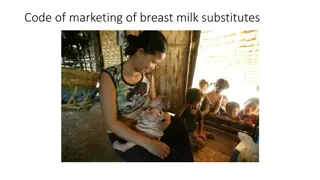Breastfeeding Basics: Nourishing Your Child and Building Immunity
Breastfeeding provides numerous benefits for both the baby and mother, including optimal nutrition, antibodies for immunity, weight management, bonding time, and lower risk of diseases. Learning about proper latching techniques, milk production, positions for breastfeeding, and understanding the benefits can help mothers successfully breastfeed their infants.
Download Presentation

Please find below an Image/Link to download the presentation.
The content on the website is provided AS IS for your information and personal use only. It may not be sold, licensed, or shared on other websites without obtaining consent from the author.If you encounter any issues during the download, it is possible that the publisher has removed the file from their server.
You are allowed to download the files provided on this website for personal or commercial use, subject to the condition that they are used lawfully. All files are the property of their respective owners.
The content on the website is provided AS IS for your information and personal use only. It may not be sold, licensed, or shared on other websites without obtaining consent from the author.
E N D
Presentation Transcript
Breast Feeding Basics Nourishing your child & building immunity.
Benefits of Breast Feeding Breast milk provides optimum nutrition for infants. Breast milk has the perfect combination of, vitamins, proteins and fats. Breast milk is easier to digest than formula. Breast milk contains antibodies to help baby fight off viruses and bacteria. Breast milk lowers the baby's risk of allergies. Breast fed babies are more prone to gain the right amount of weight as they grow.
Benefits of Breast Feeding: for Mom Breast feeding helps mom to get back to her pre-pregnancy weight, by burning extra calories. Lowers risk of ovarian cancer. Less expensive than formula. Bonding time for mother and baby.
Can I make enough milk to breast feed? Colostrum is the initial, first milk that your breast begin to make, it usually last for three days. This milk prepares your newborns digestive tract for breast milk. Breast feeding is based on the laws of supply and demand. The more you nurse your infant with breast milk, the more milk you will produce. This is true if you breast feed exclusively for the first six months of the infants life, (no formula, juice or water).
Best Positions for Breast Feeding Cradle position; Football Position; Side-lying
How do I get my baby to Latch On to breast feed? Position baby facing you, in a comfortable position for you, and the baby. With one hand hold your breast, specifically the nipple to your baby s mouth. Baby should instinctively open his/her mouth. Supporting the baby s back with your hand, try placing your nipple in the center of the baby s mouth above their tongue. Both of baby s lips should be around the areola of your breast.
Latching On Correctly Breast feeding should not be painful. You will feel tugging and tingling. IF baby is not latched on correctly you will feel pain and sore nipples. Simply insert pinky into baby s mouth and break the seal between, baby s gum and nipple and try again. The most important thing is to try to remain calm and breath. Frustration can set in easily, if you are uncomfortable and baby is not feeding correctly. Patience is key
Important Tips to Breastfeeding: Look for signs of hunger: Baby moving hands to their mouths Baby making sucking noises Baby moving mouth Crying, (late sign of hunger) Newborns nurse eight to twelve times in a 24 hour period; ON DEMAND feeding. Be patient with yourself: Breast feed baby as long as they want Typically will nurse from 10 20 minutes on each breast Try not to rock baby so they do not fall asleep on breast Rub bottom of foot to keep them awake and engaged in feeding
Important Tips to Breastfeeding: Make yourself comfortable Be sure to be in a calm, quiet environment where you can relax A relaxing environment will stimulate the let down of your milk Prop pillows for comfort Arms Neck Head Shoulder Use a foot rest to support your legs and feet while you breast feed. This is a once in a life time opportunity that bonds you to your baby. This is a once in a life time opportunity that bonds you to your baby.
Complications of Breastfeeding Sore Nipples Sore nipples are expected in the first few weeks of breastfeeding. Proper latching on Nipple guards Rub nipples with expressed milk before/after feedings Cooling nipple pads Nipple cream lanolin, helps protect cracked nipples Do not use soap to wash nipples as it dries and can further irritate nipples
Complications of Breastfeeding (cont.) Worried about mild production A baby that is wetting six to eight diapers a day is getting enough milk. Avoid supplementing your baby with formula or water. You need to feed frequently/pump for your body to produce more milk; supply and demand. Drink plenty of water to keep your self hydrated. Pumping and storing milk Breast milk can be pumped and stored. 2 days in refrigerator 6 months in freezer Never thaw in microwave, thaw in a bath of warm water
Complications of Breastfeeding (cont.) Inverted Nipples Consult a lactation consultant, (available at hospital after delivery) for tips on how to successfully feed baby. Breast Engorgement - This happens when your breast are full of milk, your breast may feel hard and painful. Nursing the baby will relieve the discomfort as well as using a breast pump. Standing in a warm shower will also start the milk flow to relive breast engorgement. Blocked Milk Ducts A milk duct that has become plugged with breast milk, it feels like a painful, hot pump on your breast. Relieved by: Applying warm compresses Gentle message of duct Continued nursing
Complications of Breastfeeding (cont.) Breast Infection (Mastitis) This happens when bacteria is introduced through cracked nipples. The breast can feel sore and you my have flu like symptoms, you MUST call your doctors. Treated with antibiotics May continue to breast feed to reduce pain and/or pump to continue supply Stress Stress can interfere with your natural, let down of milk. Let down of milk happens when you are relaxed and when your baby cries. Important thing to remember is that you and your baby are new at this and it will take time to get use to and perfect. Patience and perseverance is key; take deep breaths and enjoy the bonding experience.
Breastfeeding Support La Leche League - http://www.llli.org/ Lactation Consultant at hospital where you are delivering Babycenter.com
References Health & Baby Breastfeeding Overview. (2013). Retrieved from http://www.webmd.com/parenting/baby/nursing-basics Leifer, G. (2007). Introduction to Maternity and Pediatric Nursing. St. Louis, Missoouri: Mosby, Elsevier.
How to contact us? Ms. Lorna Owens, Executive Director 4000 Ponce de Leon Blvd,Suite 470 P. 305-573-8423, F. 305-854-2980 Email: lorna@footprints-foundation.org twitter@footprints congo www.footprints-foundation.org























